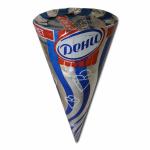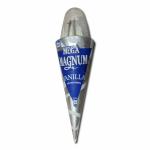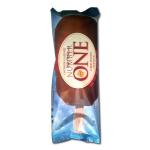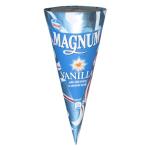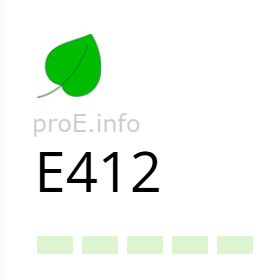
Other names for the additive (synonyms)
General Information
Guaran or guar gum (additive E412) is used in the food industry as a stabiliser, thickener, and emulsifier.
Guar gum belongs to the group of polysaccharides and is a water-soluble substance. In terms of its chemical composition, it is similar to locust bean gum (additive E410). It is a polymer compound that contains galactose residues. Guaran is quite tough and has increased elasticity and water solubility. Because of these properties, additive E412 is considered a highly efficient emulsifier and stabiliser. This additive also demonstrates good resistance to freeze–thaw cycles in food products.
Guar gum is extracted from guar beans (pods of the Indian cluster bean), which are primarily cultivated in India and Pakistan. About 80% of the global production of guar gum comes from India. It is also produced in the USA, Africa, Canada, and Australia.
The production method of additive E412 involves extracting the substance from the seeds of the Cyamopsis tetragonolobus plant. It is supplied to food processing facilities as a pale powder with a white hue.
Main characteristics of additive E412:
- Odour – none or faint, characteristic.
- Taste – neutral.
- Colour – white with a greyish or yellowish tint.
- Consistency – powder.
Effects on the Body
Benefits of Additive E412
Guar gum is practically not absorbed by the human intestines, which is why additive E412 is considered harmless to health.
This additive reduces appetite and effectively lowers elevated levels of saturated fats and cholesterol in the body. Guar gum also:
- helps eliminate toxins and harmful bacteria from the intestines,
- increases calcium absorption by the body,
- is used in dietary nutrition by promoting a feeling of fullness.
Additive E412 is often included in diabetic medications to slow down the absorption of sugar in the intestines.
Risks of Additive E412
In the late 1980s, the additive was actively used in weight-loss products in the USA. As a result, at least 10 people were hospitalised with fatal outcomes due to oesophageal blockages caused by consuming large amounts of the product with insufficient fluid intake. Later research proved the ineffectiveness of guar gum in weight reduction.
Uses
The main property of guar gum is its ability to slow down the crystallisation of ice in various frozen foods. For this reason, it is especially used in ice cream and the production of various chilled confectionery items.
As a stabiliser, additive E412 is also used in:
- the meat industry – it increases the viscosity of minced meat and helps increase its volume;
- bakery production – additive E412 prolongs shelf life and improves product flexibility;
- cheese and dairy production (yogurt, kefir, milk) – as a stabiliser and filler that accelerates ripening and increases volume;
- the making of jellies, jams, frozen desserts – additive E412 thickens the mass and improves texture;
- salad production – guar gum improves visual appearance;
- the manufacture of seasonings, ketchup, mayonnaise, fats, oils – the stabiliser helps preserve product integrity and creates a homogeneous texture;
- the production of syrups, juices, food concentrates, instant soups, and quick-cooking cereals – additive E412 enhances product texture.
Additionally, stabiliser E412 can be found in pet food.
Other uses of guar gum include:
- textile industry;
- paper production;
- manufacture of explosives;
- cosmetics industry (additive E412 is used as a conditioner in shampoos and a thickener in toothpaste);
- pharmaceutical industry (the stabiliser is used as a binder in tablets);
- oil and gas industry;
- coal industry.
Legal Status
Additive E412 is permitted for use in Ukraine, the EU, and the USA both as an individual food additive and in combination with other substances.
